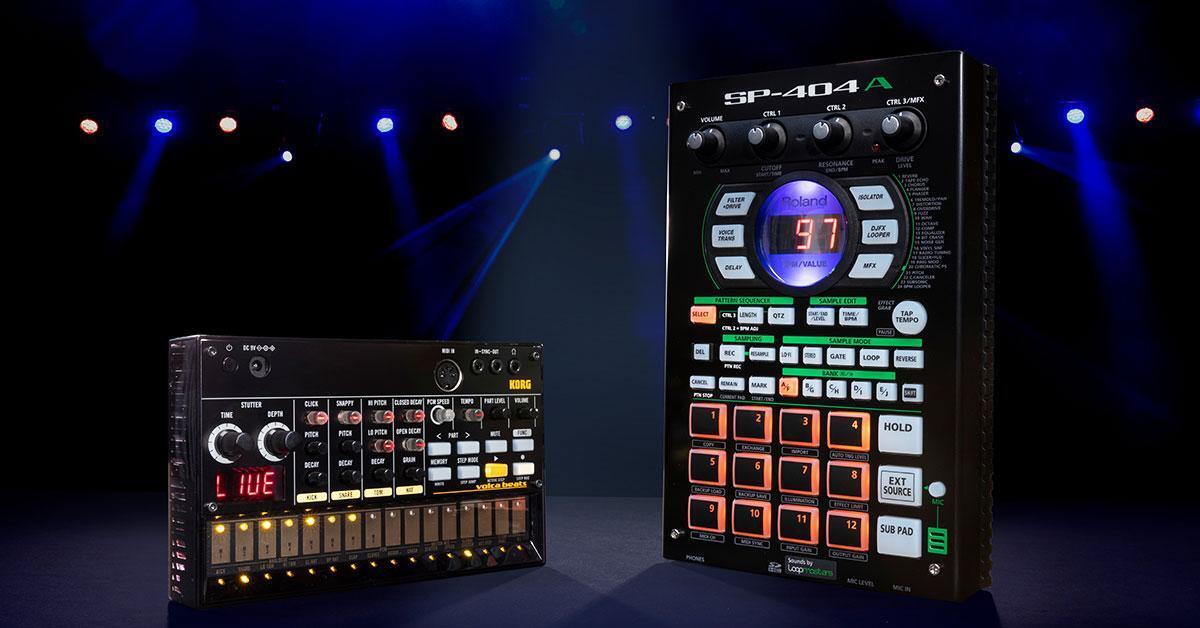A sampler plays back recorded sounds while a synthesizer creates its own sounds from oscillators and filters. Both samplers and synthesizers have been essential tools for music production for decades.
There are however, significant differences between these two digital audio workstations. Samplers, as the name suggests, take audio samples and manipulate them through various processes such as pitch shifting, looping, and filtering. On the other hand, synthesizers generate sound waves through oscillators and manipulate them using filters, envelopes and modulations.
Understanding these differences is crucial for music producers, as they can determine the type of sounds you can produce, and the limitations of each respective instrument. This article will delve deeper into the similarities, differences, and use cases of each instrument.

Credit: www.sweetwater.com
The Basics
Samplers and synthesizers are both electronic musical instruments used to create sounds, but they differ in their methods. Samplers record and play back real-world sounds, while synthesizers generate sounds electronically from scratch.
When it comes to the world of music production, there are several essential equipment that you should be familiar with. Two of those are samplers and synthesizers.
Definition Of Sampler
A sampler is an electronic device that records and plays back audio samples. In simple terms, it’s a digital instrument that allows you to take snippets of audio from one source and manipulate or combine them to create new sounds. Samplers come in different types, but they all share the same goal: to create new sounds from pre-existing audio.
Definition Of Synthesizer
On the other hand, a synthesizer is an electronic musical instrument that generates sound using various methods. Rather than using pre-existing audio as a starting point, synthesizers create sound from scratch, using mathematical algorithms to generate waveforms. These waveforms can then be shaped and manipulated to create a wide variety of sounds, from traditional instrument sounds to futuristic and abstract tones. In summary, samplers use pre-existing audio to create new sounds, while synthesizers generate sound from scratch using mathematical algorithms. Understanding the difference between these two instruments is crucial for any aspiring music producer who wants to create unique sounds and music.

Credit: m.youtube.com
Functionality
A synthesizer produces new sounds electronically from scratch while a sampler records and plays back audio clips. A synthesizer creates an original sound, while a sampler reproduces already existing ones. Knowing their differences is crucial to make informed choices when choosing a musical instrument.
When it comes to music production, samplers and synthesizers are essential tools for creating unique sounds and beats. While both instruments are electronic devices used to generate sound, their functionality is quite different. Samplers allow users to record and manipulate audio samples while synthesizers use electronic oscillators to create sounds from scratch. Let’s explore the functionality of these devices further.
How Samplers Work
Samplers record audio clips and play them back at various pitches and speeds. They consist of two primary components: a sampler engine and a set of sample libraries. The engine processes the audio and allows users to modify it with effects, filters, and other settings. While the sample library gives access to pre-recorded sounds, including drums, vocals, and instruments.
How Synthesizers Work
Synthesizers, on the other hand, generate sound through a combination of oscillators, filters, and amplifiers. Users can create a range of sounds by manipulating the waveform, adjusting the filters, and changing the envelope parameters. Synthesizers are used to create sounds from scratch that are not easily generated with traditional instruments.
Sampling And Playing Back Audio
When it comes to sampling and playing back audio, samplers have the upper hand. They allow users to record real-world sounds and manipulate them in a variety of ways. In contrast, synthesizers operate by creating new sounds from scratch, which may not always be suitable for certain music genres.
Creating Sounds From Scratch
If you’re looking to create your sounds from scratch, a synthesizer is the go-to choice. Synthesizers give musicians complete control over creating unique sounds that cannot be found in any pre-recorded sample library. They allow users to experiment with different waveforms and filters to generate unique sounds and tones. In conclusion, both samplers and synthesizers have their unique functionalities and benefits in music production. Understanding the difference between the two is fundamental in choosing the right tool for the job. Whether you’re creating your unique sounds or manipulating pre-recorded samples, both instruments are essential for producing music that stands out.
Sound Quality
A sampler and a synthesizer differ in their sound quality. A sampler records and plays back real-world acoustic sounds while a synthesizer generates sounds electronically. Each has its strengths, with samplers offering natural sounds and synthesizers providing endless possibilities for customization.
Sampling Versus Synthesizing Sound
The sound quality of a sampled sound and a synthesized sound varies significantly. When it comes to sampling sound, a portion of a pre-recorded sound is captured and used later in a sampler for playback. On the other hand, synthesizing involves creating new sounds that are not pre-recorded or stored.
Pros And Cons Of Sampling
Sampling is an efficient method of reproducing sounds that are difficult or impossible to replicate. Using a sampler means that you can take a snippet of a sound that is unique, and replicate it multiple times. Additionally, the sampled sounds can be manipulated in many ways, such as pitch, tempo, and timbre. With these options, the sounds can be modified to create an entirely new sound. However, the quality of a sampled sound depends on the resolution of the original sound source and the number of samples used.
Pros And Cons Of Synthesizing
Unlike sampling, synthesizing produces original sounds that can be manipulated in many ways. A synthesizer allows users to create a wide range of sounds, from simple to complex. This variety of sounds makes synthesizers the go-to instrument for many music producers and sound artists. However, the quality of the synthesizer sound can vary depending on the type of synthesis used, the quality of the sound-card, and the output of the instrument. In conclusion, the choice between using a sampler and a synthesizer comes down to personal preference and the task at hand. Both have their advantages and disadvantages, and the quality of the sound produced will depend on how they are used.

Credit: www.reddit.com
Application
Samplers record and manipulate real sounds, while synthesizers generate electronic sounds from scratch. A sampler allows a musician to play back prerecorded sounds in various ways, while a synthesizer creates electronic waveforms that can be shaped and modulated to create new sounds.
The ultimate choice depends on the intended use and personal preference.
Best Use Cases For Samplers
Best Use Cases For Synthesizers
Modern Applications
When it comes to creating electronic music, both samplers and synthesizers play a critical role. Understanding the difference between the two can help you choose the right tool for your music making. Samplers and synthesizers have their own strengths and weaknesses, and each one is suited to particular applications. Knowing when to use a sampler and when to use a synthesizer can make a big difference in the quality of your music.
Best Use Cases For Samplers
A sampler allows you to record and manipulate audio samples. This is perfect for creating beats and rhythms, as well as for adding texture and variety to your tracks. Here are some of the best use cases for samplers:
- Creating your own beats and drum loops
- Sampling and manipulating sounds from the real world
- Adding unique textures and layers to your tracks
- Creating your own sample library for future use
Best Use Cases For Synthesizers
A synthesizer generates sounds from scratch, making it a powerful tool for creating your own unique sounds. Here are some of the best use cases for synthesizers:
- Creating your own unique sounds for lead melodies and basslines
- Adding pads and atmospheric sounds to your tracks
- Experimenting with sound design and synthesis techniques
- Layering and processing synthesized sounds to create complex textures
Modern Applications
Both samplers and synthesizers are still widely used in modern music production, but their functions have expanded over time. Here are some modern applications for both samplers and synthesizers:
| Samplers | Synthesizers |
|---|---|
| Chopping up and manipulating samples in real-time while performing live | Using digital modeling and synthesis techniques for more detailed and realistic sounds |
| Sampling and resampling to create unique soundscapes and textures | Using software synthesizers to create complex layered sounds |
| Creating sample-based instruments for use in live performance | Using modular synthesizers to create complex, modular sound systems |
Frequently Asked Questions Of What Is The Difference Between A Sampler And A Synthesizer
How Is A Sampler Different From A Synthesizer?
A sampler records and plays back audio while a synthesizer generates sound electronically. Samplers use real audio clips while synthesizers use generated sound waves.
What Is The Difference Between Sampling And Synthesis?
Sampling involves capturing and reusing existing audio recordings, while synthesis generates entirely new sounds either from scratch or by manipulating existing sounds. Sampling is a digital recording technique while Synthesis is an electronic process to create artificial sounds.
What Is The Purpose Of A Sampler?
A sampler is a musical instrument or sound device used to record and manipulate sounds or music. Its purpose is to capture and store sounds for later use in composing, editing, or performance. Samplers are used in various music genres such as hip hop, electronic, and pop music.
What Is The Difference Between A Sampler And A Sequencer?
A sampler is used for recording and playing back audio samples. A sequencer is used for arranging and triggering those samples into a musical composition. The sampler captures individual sounds, while the sequencer combines and plays them in a specific sequence.
Conclusion
Overall, there are fundamental distinctions between a sampler and a synthesizer, though they share similar sound creation purposes. A sampler records and plays back real-world sounds, while a synthesizer generates original sounds using sound waves in oscillators. Choosing between a sampler and synthesizer depends on the intended purpose, desired sound, and budget.
Whichever you opt for, ensure to master using the instrument and understand its features to create exceptional sounds.